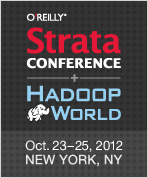Where does all the data in “big data” come from? And why isn’t big data just a concern for companies such as Facebook and Google? The answer is that the web companies are the forerunners. Driven by social, mobile, and cloud technology, there is an important transition taking place, leading us all to the data-enabled world that those companies inhabit today.
From exoskeleton to nervous system
Until a few years ago, the main function of computer systems in society, and business in particular, was as a digital support system. Applications digitized existing real-world processes, such as word-processing, payroll and inventory. These systems had interfaces back out to the real world through stores, people, telephone, shipping and so on. The now-quaint phrase “paperless office” alludes to this transfer of pre-existing paper processes into the computer. These computer systems formed a digital exoskeleton, supporting a business in the real world.
The arrival of the Internet and web has added a new dimension, bringing in an era of entirely digital business. Customer interaction, payments and often product delivery can exist entirely within computer systems. Data doesn’t just stay inside the exoskeleton any more, but is a key element in the operation. We’re in an era where business and society are acquiring a digital nervous system.
As my sketch below shows, an organization with a digital nervous system is characterized by a large number of inflows and outflows of data, a high level of networking, both internally and externally, increased data flow, and consequent complexity.
This transition is why big data is important. Techniques developed to deal with interlinked, heterogenous data acquired by massive web companies will be our main tools as the rest of us transition to digital-native operation. We see early examples of this, from catching fraud in financial transactions, to debugging and improving the hiring process in HR: and almost everybody already pays attention to the massive flow of social network information concerning them.

From digital exoskeleton to nervous system.
Charting the transition
As technology has progressed within business, each step taken has resulted in a leap in data volume. To people looking at big data now, a reasonable question is to ask why, when their business isn’t Google or Facebook, does big data apply to them?
The answer lies in the ability of web businesses to conduct 100% of their activities online. Their digital nervous system easily stretches from the beginning to the end of their operations. If you have factories, shops and other parts of the real world within your business, you’ve further to go in incorporating them into the digital nervous system.
But “further to go” doesn’t mean it won’t happen. The drive of the web, social media, mobile, and the cloud is bringing more of each business into a data-driven world. In the UK, the Government Digital Service is unifying the delivery of services to citizens. The results are a radical improvement of citizen experience, and for the first time many departments are able to get a real picture of how they’re doing. For any retailer, companies such as Square, American Express and Foursquare are bringing payments into a social, responsive data ecosystem, liberating that information from the silos of corporate accounting.
What does it mean to have a digital nervous system? The key trait is to make an organization’s feedback loop entirely digital. That is, a direct connection from sensing and monitoring inputs through to product outputs. That’s straightforward on the web. It’s getting increasingly easier in retail. Perhaps the biggest shifts in our world will come as sensors and robotics bring the advantages web companies have now to domains such as industry, transport, and the military.
The reach of digital nervous system has grown steadily over the past 30 years, and each step brings gains in agility and flexibility, along with an order of magnitude more data. First, from specific application programs to general business use with the PC. Then, direct interaction over the web. Mobile adds awareness of time and place, along with instant notification. The next step, to cloud, breaks down data silos and adds storage and compute elasticity through cloud computing. Now, we’re integrating smart agents, able to act on our behalf, and connections to the real world through sensors and automation.
Coming, ready or not
If you’re not contemplating the advantages of taking more of your operation digital, you can bet your competitors are. As Marc Andreessen wrote last year, “software is eating the world.” Everything is becoming programmable.
It’s this growth of the digital nervous system that makes the techniques and tools of big data relevant to us today. The challenges of massive data flows, and the erosion of hierarchy and boundaries, will lead us to the statistical approaches, systems thinking and machine learning we need to cope with the future we’re inventing.
 Strata Conference + Hadoop World — The O’Reilly Strata Conference, being held Oct. 23-25 in New York City, explores the changes brought to technology and business by big data, data science, and pervasive computing. This year, Strata has joined forces with Hadoop World.
Strata Conference + Hadoop World — The O’Reilly Strata Conference, being held Oct. 23-25 in New York City, explores the changes brought to technology and business by big data, data science, and pervasive computing. This year, Strata has joined forces with Hadoop World.
